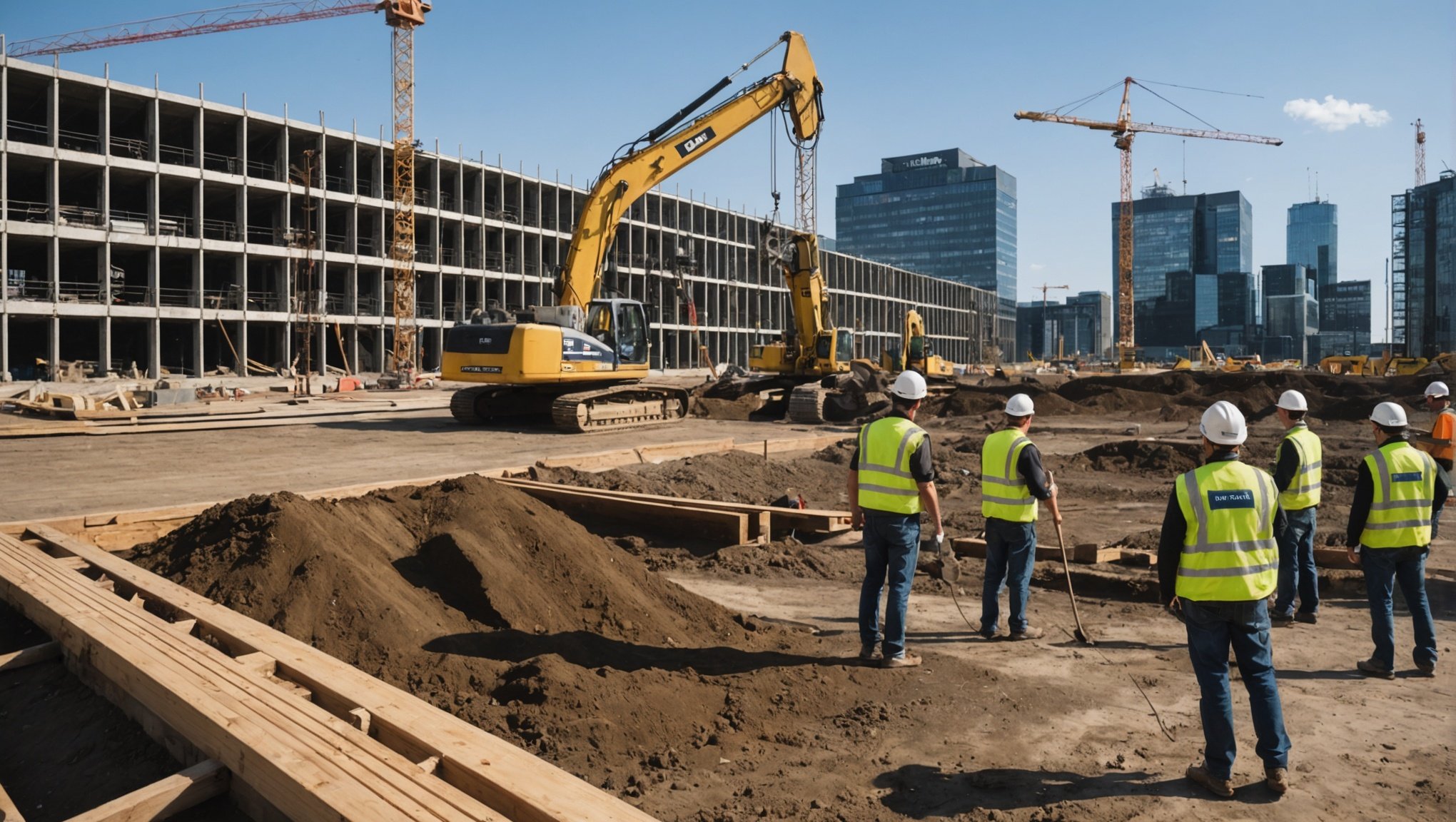Top Strategies for UK Construction Companies to Effectively Mitigate Environmental Impact
As the UK construction industry navigates the complex landscape of sustainability and environmental responsibility, it is clear that adopting innovative and sustainable practices is no longer a choice, but a necessity. Here, we delve into the top strategies that construction companies can implement to significantly reduce their environmental impact.
Embracing the Circular Economy in Construction
The traditional linear economy, based on a ‘take-make-consume-waste’ approach, is no longer viable in the face of escalating environmental challenges. The circular economy offers a promising alternative, focusing on reuse, recycling, and upcycling of materials.
Also to read : Top Strategies for Leveraging Data-Driven Marketing in the UK”s Fashion Sector
Pre-Demolition Audits and Material Reuse
Pre-demolition audits are crucial in identifying materials that can be reused or recycled, thereby minimizing waste and the environmental impact of demolition. These audits, often required as part of the BREEAM process and recommended by the London Plan, need to be enhanced beyond generic waste groups to include detailed assessments of material types and quality. This involves direct input from architects during site visits and material identification to ensure that qualifying materials are incorporated into new developments.
For example, Sweco’s sustainability experts are setting standards for ‘reuse and recycle’ at One Exchange Square in London by conducting thorough pre-demolition audits. This approach not only reduces waste but also promotes the use of high-quality materials in new constructions.
Also to read : Top Strategies for UK Small Businesses to Optimize Cash Flow Management
Collaborative Efforts and Policy Implementation
Creating circular solutions demands a collaborative effort among all stakeholders, including clients, demolition contractors, and design teams. Clients should set clear policies for circular opportunities, while demolition contractors should formulate detailed audits and work with design teams to identify materials for direct reuse or external recycling. This collaborative approach ensures that the entire supply chain is aligned towards a more circular future.
Transitioning to Alternative Energy Sources
The construction industry is a significant contributor to the UK’s carbon emissions, with diesel powering a vast array of machinery. However, alternative fuels offer a viable path to reducing these emissions.
The Case for Hydrotreated Vegetable Oil (HVO)
HVO is emerging as a promising alternative to diesel, offering a direct, drop-in replacement without requiring modifications to existing vehicles or equipment. Certas Energy, the UK’s largest independent fuel distributor, is at the forefront of this transition. Niki Holt, energy solutions marketing director at Certas Energy, highlights that HVO can significantly reduce the industry’s carbon footprint, especially given that the built environment accounts for 25% of the UK’s overall carbon emissions.
Here are some key benefits of HVO:
- Immediate Emissions Reduction: HVO can reduce greenhouse gas emissions by up to 90% compared to traditional diesel.
- Operational Efficiency: HVO does not require any changes to existing machinery, making it an immediate solution.
- Cost-Effectiveness: By reducing idle time and implementing auto shutdown features, companies can lower fuel costs and emissions simultaneously.
Optimizing Formwork for Sustainability
Formwork, a critical component in construction, is undergoing significant transformations to reduce its environmental impact.
Sustainable Materials and Practices
The industry is shifting towards more sustainable materials and practices in formwork. This includes the use of recycled plastics, biodegradable materials, and innovative formwork systems that can be reused multiple times. For instance, PERI Group’s DUO system can be reused up to 100 times, significantly reducing waste and the carbon footprint of construction projects.
Digital Technologies and 3D Printing
Digital technologies such as Building Information Modelling (BIM) and advanced simulation software are enhancing formwork design, reducing material waste, and optimizing performance. Additionally, 3D printing technology is being explored for creating bespoke formwork, which could revolutionize the industry by minimizing waste and labour requirements.
As Emma Brown, Sustainability Director at Skanska UK, notes: “The formwork of tomorrow will not only shape our buildings but also our approach to sustainable construction. It’s an exciting time to be in this field, with innovations emerging that have the potential to transform the way we build”.
Retrofit Decarbonisation and Energy Efficiency
Retrofitting existing buildings is a critical strategy for reducing the construction industry’s environmental impact, particularly in the residential sector.
Large-Scale Retrofit Projects
Companies like Sustainable Building Services are leading the way in retrofit decarbonisation, delivering projects across all housing types in the UK. Their work includes energy efficiency, low-carbon technology, and whole-house retrofit schemes that comply with standards such as PAS 2035. These projects not only improve the health, comfort, and well-being of households but also address issues like fuel poverty and the cost-of-living crisis while reducing energy consumption and carbon emissions.
Here is a snapshot of their impact:
| Project Type | Number of Projects | Impact |
|---|---|---|
| SHDF Demonstrator | 35 | Improved living conditions for thousands of households |
| PAS 2035 Retrofit | 170 | Reduced energy consumption and carbon emissions |
| Social Housing | 17,000 | Addressed fuel poverty and cost-of-living crisis |
Collaborative Project Management
Effective retrofit decarbonisation requires full collaboration among project stakeholders. Sustainable Building Services works in partnership with trusted suppliers and partners to ensure projects are delivered in compliance with standards and funding requirements. This collaborative approach is crucial for maximizing impact and ensuring that projects are completed within industry-leading timeframes.
Reducing Waste and Promoting Sustainable Practices
Waste reduction is a cornerstone of sustainable construction practices.
Minimizing Construction Waste
The European Commission’s Circular Economy Action Plan sets a target of recycling 70% of all construction waste from 2020 onwards. To achieve this, construction companies must adopt robust waste management strategies, including pre-demolition audits and the use of material passports. These tools help in identifying materials for reuse, downcycling, or upcycling, thereby reducing the amount of waste sent to landfills.
Sustainable Building Materials
The use of sustainable building materials is another key strategy. This includes materials made from recycled plastics, biodegradable materials, and those with lower carbon footprints. For example, formwork made from recycled plastics can significantly reduce waste and the environmental impact of construction projects.
Implementing Clean Energy Technologies
Clean energy technologies are revolutionizing construction sites by reducing emissions, enhancing efficiency, and improving safety.
Renewable Energy and Energy-Efficient Solutions
Technologies such as hydrotreated vegetable oil (HVO), electric vehicles, and renewable energy systems are becoming increasingly prevalent. HVO, as mentioned earlier, is a direct replacement for diesel, while electric vehicles, despite their current limitations, offer a cleaner alternative for certain types of machinery. Additionally, renewable energy systems like solar and wind power can be integrated into construction sites to reduce reliance on fossil fuels.
Here are some clean energy technologies making an impact:
- HVO: Reduces greenhouse gas emissions by up to 90%.
- Electric Vehicles: Reduces air and noise pollution, though currently limited by charging infrastructure and battery technology.
- Renewable Energy Systems: Solar and wind power can be used to power construction sites, reducing reliance on fossil fuels.
The UK construction industry stands at a pivotal moment in its journey towards sustainability. By embracing the circular economy, transitioning to alternative energy sources, optimizing formwork, retrofitting existing buildings, reducing waste, and implementing clean energy technologies, construction companies can significantly mitigate their environmental impact.
As the industry continues to evolve, it is crucial for companies to collaborate, innovate, and adopt sustainable practices that not only reduce emissions but also enhance efficiency, safety, and cost-effectiveness. The future of sustainable construction is exciting and full of potential, with innovations emerging that have the power to transform the way we build.
In the words of Emma Brown from Skanska UK, “The formwork of tomorrow will not only shape our buildings but also our approach to sustainable construction.” This sentiment encapsulates the broader vision for the construction industry—a vision where sustainability is not just a goal, but a fundamental aspect of every project.











